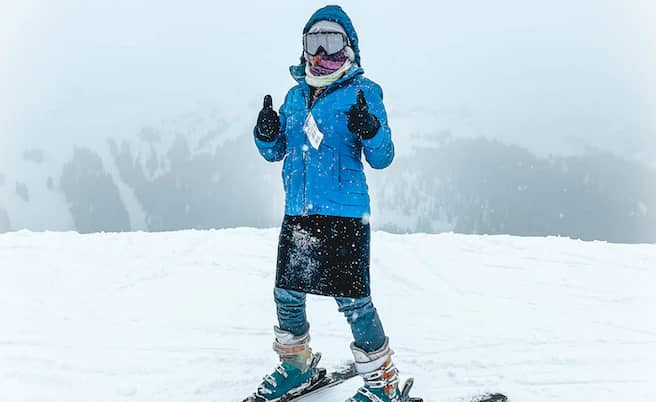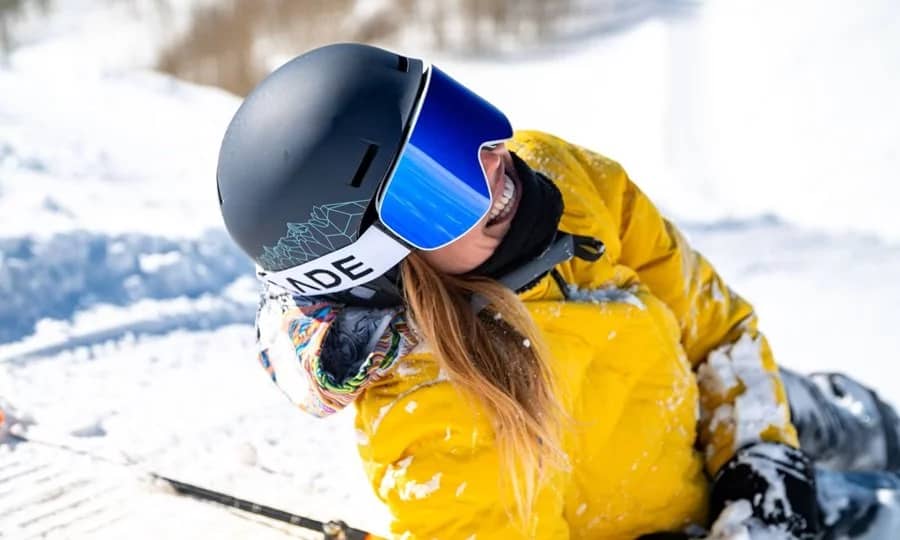Table of Contents
Introduction
Skiing: A Symphony of Excitement and Challenge
Imagine standing atop a snow-clad mountain, the crisp air brushing against your face, your heart thumping with anticipation. That’s skiing for you – a sport that combines the thrill of speed with the serene beauty of winter landscapes. But here’s a skier’s secret: the joy and comfort of skiing rely heavily on what you wear. Yes, your skiing attire isn’t just about fashion; it’s about functionality, safety, and comfort. In this comprehensive guide, we’re diving deep into the world of skiing apparel for first-timers. Whether you’re planning to gracefully glide down gentle slopes or conquer challenging trails, understanding what to wear skiing first time is your first step towards an unforgettable experience on the snow.
Why Does Skiing Attire Matter So Much?
You might wonder, “Can’t I just wear my regular winter clothes?” The answer lies in the unique demands of skiing. This exhilarating sport requires clothing that can keep you warm in sub-zero temperatures, protect you from wet and windy conditions, and offer enough flexibility for movement. Moreover, the right attire plays a crucial role in preventing hypothermia and frostbite – two common risks associated with cold-weather activities. It’s a delicate balance between insulation and breathability, ensuring that you stay warm without overheating.
But fear not! You don’t need to be a fashion guru or a skiing pro to get this right. This article is your personal guide to mastering the art of dressing for skiing. We’ll walk you through each layer, explain why each piece is essential, and offer tips to choose the best options for your first skiing adventure. So, buckle up your ski boots, and let’s embark on this journey to make your first skiing experience as comfortable and enjoyable as possible!

Understanding the Ski Environment
The Unique Challenge of the Mountains
Before we dive into the layers of clothing, it’s crucial to understand the environment you’ll be embracing. Ski slopes are a world apart from your typical winter setting. Here, you’re not just battling the cold; you’re also dealing with variable weather conditions, from bright sunny days to unexpected snowstorms. The altitude plays a significant role too, often intensifying the cold and increasing exposure to UV rays. Understanding these conditions is key to choosing the right attire that keeps you comfortable, safe, and ready to enjoy the slopes.
Why Appropriate Clothing Matters
- Temperature Variability: On the mountain, temperatures can fluctuate dramatically. The right clothing helps regulate your body temperature, ensuring you stay warm without overheating during physical exertion.
- Wet and Windy Conditions: Snow isn’t just about cold; it’s often wet, especially if you fall. Windchill can also be a factor, making it feel much colder than it actually is. Waterproof and windproof clothing is essential to stay dry and protected.
- UV Exposure: Higher altitudes mean increased exposure to UV rays, which can be harmful to your skin. Protective clothing and accessories become crucial to shield yourself from sunburn and UV damage.
- Safety: In skiing, falls are common, especially for beginners. Durable outerwear provides a layer of protection against scrapes and bruises, and specific gear like helmets is non-negotiable for head protection.
Understanding these environmental factors is the first step in preparing for your skiing adventure. With this knowledge, you’re better equipped to make informed choices about your skiing wardrobe, ensuring that your focus remains on learning and enjoying the sport, rather than battling discomfort and the elements.


The Base Layer: Your Foundation for Warmth
The Unsung Hero of Ski Attire
When it comes to skiing, the base layer is much more than just another piece of clothing. It’s your personal climate control system. Acting as a second skin, the base layer’s primary role is to manage moisture and maintain body heat, crucial for staying comfortable on the slopes. Let’s explore why the base layer is an indispensable part of your skiing gear.
Importance of Moisture-Wicking Materials
- Moisture Management: As you ski, your body generates heat, leading to perspiration. A good base layer wicks away this moisture from your skin, keeping you dry. This is vital because damp skin significantly increases the risk of rapid heat loss, making you feel cold and uncomfortable.
- Material Matters: Look for base layers made from synthetic materials like polyester or natural fibers like merino wool. These materials are excellent at moisture-wicking, quick-drying, and maintaining warmth even when wet. Avoid cotton, as it tends to absorb moisture, keeping you damp and cold.
Recommended Base Layer Types
- Lightweight to Midweight Options: The weight of your base layer should depend on the weather conditions and your personal preference. Lightweight base layers are ideal for milder conditions or if you tend to heat up quickly. Midweight options offer more insulation for colder days.
- Fit and Comfort: A proper base layer should fit snugly without restricting movement. Look for stretchable fabrics that offer flexibility, as skiing requires a wide range of motion. Flat seams and non-irritating materials add to the comfort, ensuring your focus stays on skiing, not on skin chafing.
- Layering Flexibility: A good base layer also provides the foundation for additional layers. It should be thin enough to fit comfortably under your insulation and outer layers, yet effective in its primary role of moisture management and warmth retention.

The Insulation Layer: Keeping the Heat In
The Crucial Middle Layer in Skiing Attire
After establishing a solid base layer, the next step in deciding what to wear skiing for the first time is selecting the right insulation layer. This layer plays a crucial role in retaining the body heat your base layer has worked hard to preserve. Let’s dive into how to choose the best insulation layer for your skiing adventure.
Types of Insulation Layers
- Fleece Jackets and Wool Sweaters: These are popular choices for their excellent balance between warmth and breathability. They trap heat effectively while allowing moisture to escape, keeping you warm without overheating.
- Down and Synthetic Insulators: Down jackets offer superior warmth and are lightweight, but they lose their insulating properties when wet. Synthetic insulators, on the other hand, perform better in damp conditions and are usually more budget-friendly.
Material and Thickness Considerations
- Weather and Activity Level: The thickness of your insulation layer should be chosen based on the weather and your level of activity. In colder conditions, a thicker layer might be necessary, whereas, for active skiing or milder weather, a thinner layer may suffice.
- Layering Flexibility: The insulation layer should fit comfortably over your base layer without being too bulky. This ensures ease of movement, which is vital for skiing. It should also allow for adding or removing layers as weather conditions change throughout the day.
The Outer Layer: Protection Against the Elements
Your Shield in the Ski Environment
The outer layer is what most people envision when they think about what to wear skiing for the first time. This layer is your primary defense against the external elements – snow, wind, and even the occasional rainfall. Here’s what to look for in an effective outer layer.
Features of a Good Ski Jacket and Pants
- Waterproof and Windproof: Look for materials that are both waterproof and windproof to keep you dry and shielded from the chill. Features like taped seams and waterproof zippers enhance these properties.
- Breathability: While keeping out water and wind, your outer layer should also allow sweat and moisture to escape. This prevents overheating and maintains comfort throughout your skiing session.
Importance of Waterproof and Windproof Materials
- Staying Dry: Waterproof materials prevent snow and moisture from penetrating, which is essential for staying warm. Wet clothing loses its insulating properties and can lead to a rapid decrease in body temperature.
- Blocking the Wind: A windproof outer layer is crucial in reducing the wind chill factor, a common challenge in mountainous environments. It helps maintain body warmth by shielding you from icy winds.
Choosing the right outer layer is a critical decision in what to wear skiing first time. It’s the final layer that locks in warmth from your base and insulation layers while protecting you from the harsh elements you’ll face on the slopes.
Conclusion
Embarking on Your Skiing Journey with Confidence
As we wrap up our guide on what to wear skiing for the first time, it’s clear that the right clothing can make a significant difference in your skiing experience. From the moisture-wicking base layer that keeps you dry, through the warmth-preserving insulation layer, to the protective outer layer shielding you from the elements, each piece plays a vital role in your comfort and safety on the slopes.
Remember, skiing is not just about mastering the turns and enjoying the exhilarating descents; it’s also about being well-prepared to face the unique environment of the mountains. By carefully selecting each layer of your ski attire, you set yourself up for a more enjoyable, comfortable, and memorable skiing adventure.
As a first-time skier, it’s normal to feel a mix of excitement and nervousness. But with the right gear, you can focus on the joy of skiing, knowing you’re well-equipped to handle the cold and the challenges of the slopes. So, gear up with the knowledge you’ve gained about what to wear skiing for the first time, and get ready to embrace the beautiful world of skiing with confidence and style!
FAQ Section
- What should I wear for my first skiing experience?
- Layer your clothing. Start with moisture-wicking thermal underwear, add an insulating layer like a fleece, and finish with a waterproof, breathable jacket and pants. Don’t forget a hat or helmet, gloves, and proper ski socks.
- Layer your clothing. Start with moisture-wicking thermal underwear, add an insulating layer like a fleece, and finish with a waterproof, breathable jacket and pants. Don’t forget a hat or helmet, gloves, and proper ski socks.
- Is a ski-specific jacket necessary for beginners?
- While not mandatory, a ski-specific jacket offers benefits like better insulation, waterproofing, and convenient pockets for ski passes and essentials.
- While not mandatory, a ski-specific jacket offers benefits like better insulation, waterproofing, and convenient pockets for ski passes and essentials.
- What kind of pants are appropriate for skiing?
- Wear waterproof ski pants. Avoid jeans or non-waterproof materials, as they can get wet and cold.
- Wear waterproof ski pants. Avoid jeans or non-waterproof materials, as they can get wet and cold.
- Should I invest in ski gloves or mittens?
- Ski gloves or mittens are essential. They should be waterproof and insulated. Mittens are usually warmer but offer less dexterity than gloves.
- Ski gloves or mittens are essential. They should be waterproof and insulated. Mittens are usually warmer but offer less dexterity than gloves.
- Are there any accessories that are a must for first-time skiers?
- Definitely. A good pair of goggles is crucial for visibility and eye protection. Also, consider a neck gaiter or face mask for extra warmth.





No responses yet